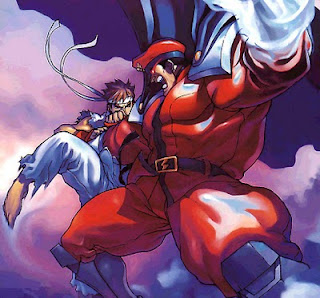
In the mid-late 90’s everybody and their grandma was playing fighting games. Whether it was Street Fighter, Marvel vs. Capcom, Tekken, Guilty Gear, King of Fighters, Virtua Fighter, etc., fighting games were dominant in the arcade scene and early home consoles. Before the era of 90s fighting games multiplayer video games were more about co-op and beating the game together with your buddies in order to advance. Which is a fun time when you had some friends over and blasted 80’s hair metal and ate large pepperoni pizzas, but nothing really to get competitive over. Competitive gaming at that time wasn’t fully realized but there were some games players could compete over, like puzzle and sports games, as well as speedrunning through the game by yourself and screenshotting it with your polaroid camera to brag about it at school. But then… it came.
The Birthplace of The Strongest

In March 1991, the legendary Street Fighter II made by Capcom was released across Japanese and U.S. arcades. It brought a fresh new type of experience of hype and excitement to the masses. Everybody was talking about it at school as it was a worldwide phenomenon.
You kept hearing everybody who goes to the arcade talk about how they have the best Ken and you don’t know who or what a Ken is or what all the fuss is about. You go to your local pizza parlor, donut shop or arcade to see what’s going and you see it. a giant machine with a huge monitor, accompanied with two arcade sticks each coming with their own set of buttons. You see characters throwing magical fireballs, performing outlandish maneuvers like 500 ft. spinning piledrivers and posing after a successful victory. You put your quarter into the machine and hear “Round 1… FIGHT!” as you fight some other kid from another middle school and claim victory along with salty tears from your opponent.
Joining Capcom, fighting game titans like Arc System Works(Arcsys), SNK and Bandai Namco reigned in with titles like Guilty Gear, King Of Fighters, and Tekken, each putting their own twist on the genre. Tekken was a fully realized 3D hand-to-hand combat experience where there were no limitations in terms of background and design. King of Fighters was an aggregation of SNK’s past properties that had them all fight in 3v3 tournament style battles. Guilty Gear had a crazy anime of combat with air combos, airdashing and anime characters with hyper powerful moves that dominated the match.
This was a new paradigm of multiplayer games. These were games where rivalries were made, friendships broken and enemies created. A true test of skill among players to see who was the best among the rest! This was the birth of what we now know… as “competitive gaming.” From small local tournaments with 8-player brackets to huge international majors with thousands of competitors… fighting games were the foundation of what we now know as competitive gaming. Soon other genres like FPS were soon to take up the formula with games like Quake and CS:GO and RTSs would be formatted to be giant MOBA goliaths like League of Legend and DOTA 2. Competitive gaming would not have happened if it wasn’t for the fighting game genre. And it’s thanks to these games we have some of the hypest moments in video game history.
But sadly… that is where the relevancy for fighting games came to a halt after the mid 2000’s. And for that we must understand why not only in modern times, but back then as well as to why fighting games lost their iron grip when it came to competitive gaming.
The fighting game dark ages.

In the late 90’s and early 2000’s with the advent of the internet coming into shape and games like CS and Quake coming into the market, players were able to go against other players and be able to frag each other online from the comfort of their own 46k modem off-white desktop Windows computer. And with the release of Halo 2 in 2004, that same experience was not far off to be played on home consoles either.
Competitive online gaming was becoming more convenient. You didn’t have to get your own TV and Ethernet cables and go over to your friend’s house so that he/she wouldn’t cheat you out on split screen multiplayer. You could 360 no scope them from the comfort of your own room and have them come up to you the next day and to call you a “hacker n00b,” with a huge smirk on your face.
The same kind of experience could not be said about fighting games during the early 2000’s as arcades were shutting down by then when the console market was really starting to flourish with Sony, Microsoft and Nintendo pushing out hardware that far succeeded that of games at the arcade. Places that used to have arcade cabinets replaced saw no need for them anymore since all the kids were playing the same, if not better games at home. And with the loss of arcades came a big problem for fighting games; where would they go with their birthplaces being shut down and how would they compete to try and win over a new generation of people not attached to the genre?
With flagship titles like Virtua Fighter and Tekken still pumping out games for this generation, there had to be something that held the torch right? While… yes there was Tekkens Tag Tournament, 4 and 5,and Virtua Fighter 4 along with its update named Evolution which all sold well (Virtua Fighter being the less popular but still selling more than the average), they weren’t enough to compete with the world breaking records of online FPS multiplayer that captured the atention of a young and new gaming audience. Add to the fact none of the titles I mentioned above had any online matchmaking whatsoever and the opportunity to retain a new audience was wasted.
With the major figurehead of the genre, Capcom, also not publishing a new fighting game in this era as well as other Eastern companies like Arcsys struggling to break over 100,000 copies of their golden IP Guilty Gear in the US and Japan, and SNK going through bankruptcy issues during this time with IP rights as well as gambling lawsuits, it was a long and almost unending hiatus for the fighting game genre. And while Super Smash Bros. Melee was an outlier from this era in terms of popularity, that was mainly due to the legacy it had of being a dream match of Nintendo characters fighting it out in crazy, out of this world beat-em-up combat.. More on that in a bit.
It was only until the era of the Xbox 360, Playstation 3 and Nintendo Wii did fighting games start to make a resurgence when Capcom released Street Fighter IV, selling over 9 million copies worldwide and with it, their rival companies starting to push out their own games. But by then it was already too late with games like Halo 3 selling over 14 million copies and being released one year before and with an already established player base by that point from the previous console generation.
So that begs the question; is there a place for the fighting game genre in this modern age of Battle Royale and arena games? The short answer; yes, but some things need to be done in order to bring the genre up to speed. I will explain this later, but first let us get a few misconceptions out the way and to help clarify a few things before moving on.
Common fighting game misconceptions

The first misconception is that fighting games are vastly harder than any other genre and there is no way a newbie can compete with a player who has been playing for well over two decades. This is a very common thing I hear in a lot of casual circles and it always perplexes me when I hear it because… that could be said for just about anything. It’s like if I said “there is no way a beginner boxer can defeat a 3x winning champion.” That is assuming this beginner even wanted to partake in the world stage anyway and just wanted to take up casual boxing.
It’s the same logic, but for some reason it’s always considered to be fact and truth that a new player will never beat a high-level pro and that is what will always happen permanently until the end of time. But that’s not the case. Like any skill, it must be practiced and honed. Nobody has ever done standing 720’s or 1 frame links the first time in their entire life. Just like how nobody’s ever done 360 no scopes and pentakills the first time they played Call of Duty or League. Like Fighting games with their input motions, mix-ups and combos, other games have similar strategies. Skills like Rocket and Strafe Jumping or Mana Pool Farming in League isn’t too far off from the same concepts fighting games have.
The second misconception which people might interpret from me from explaining poor sales in the PS2 era is that fighting games don’t do well financially. That’s not true. It’s nothing like Overwatch but Dragon Ball Fighterz and Tekken 7 are still record breaking games that brought more than enough revenue for Arcsys and Bandai Namco. It’s not that there is no audience for genre, and there is a dedicated fandom for it and still gets referenced in pop culture to this day with famous trademark references like the “hadouken” and “shoryuken” throughout media entertainment
The third and final misconception I hear is that fighting games just aren’t fun at a lower level, especially when somebody is better than you. While there is some truth to that, I think the truth is more at the latter half than at the former. Of course it’s not fun playing someone better than you and you get destroyed for attempting to do a special move. Neither is it fun when someone gets a 41 win killstreak on you in Quake Duels. But when it’s you and someone else at a similar skill level, it can be quite enjoyable. You can have down-to-the wire, nail biter matches while improving to get better at the game.
I wanted to discuss these misconceptions as they are generally, with the exception of number 2, intrinsic reasons why people don’t play fighting games or never will because of negative bias. There are however more than just intrinsic reasons why fighting games don’t do well and these are more extrinsic reasons that I have come to understand and cannot defend. These issues are what’s hurting fighting games Today and they need to be addressed. These are not outlandish tasks that require super genius intellect to implement either and only improve the quality of life for a game
What do fighting games need to fix today?

Poor single player content
One issue is poor single player content. A lot of fighting games outside the standard 2-player affair only have a handful of modes usually. An arcade mode where you fight a whole bunch of CPU opponents and an overpowered boss at the end, survival which is just arcade mode until you lose, and some other variation of the 2 that really isn’t all that interesting. This could be seen as developers not wanting to steer away from the core gameplay but… it gets very redundant. Not that the people who don’t enjoy those modes are wrong for enjoying them. It’s just that… you could do a lot more within the engine itself with the limitations given.
Fighting games need better network multiplayer tech
Next, and probably the biggest issue when it comes to long-term player base attention, is the netcode. Most games in the genre have abysmal online in an age where online play is paramount not just for e-sports or competition, but for long-term player engagement. Most online experiences in fighting games are laggy, terrible experiences that are guaranteed to sour the overall fun of anybody who wants to connect to the internet and just have a fun time hitting buttons.
What makes online so bad is the delay-based netcode in most of them, and not getting too technical, is the worst type of netcode. It basically creates this delay between when you press a button and when the actual attack comes out on your screen.
Now imagine this scenario in a fighting game match where you are making split-second decisions constantly and are trying to react accordingly. What you see on your screen in order to react to is now no longer a strategy that applies offline. Instead, now having to resort to an unnatural way of predicting things happening on screen which is drastically different offline and screws with your timing when it comes to combos and punishing moves..
Now don’t get me wrong here; there are games with great netcode that work just fine. Killer Instinct, Skullgirls and Fantasy Strike are good games you should play that have great “rollback netcode” -which I will cover later in this article- and those games don’t cost a lot of money or are straight up free. But sadly these games are outliers rather than the norm for the genre.
How to market a fighting game
And finally… the biggest issue I feel with fighting games that is holding them back in this modern age is having good PR with their fan base. And oh boy… where do I begin? Some companies actually have very good marketing strategies. At first, I was going to talk about the plunders of Street Fighter V and its bad netcode, but recent updates to the game and Capcom’s improvement of marketing the game in major leagues like the Red Bull Conquest series and their own circuit have made the game a lot better since its release. I could not say the same about other companies though.
Bandai Namco, SNK and Arcsys have poor marketing for their games as they barely advertise it outside of major fighting game tournaments. And when there is, it’s always very limiting in terms of what they want to show off the general public.
Just last year, SNK announced that King of Fighters XV was in development at EVO in August. It’s September of 2020 now and there hasn’t been a single word on an announcement nor trailer of the game, and that isn’t good. Imagine if Nintendo announced that the latest Super Mario game was coming out with only a logo to show and not showing any gameplay or even cinematic trailer footage. People are going to wonder “where’s the new Mario game!? They announced it over a year ago!” In this day and age long-term pre-launch marketing strategies are a key factor to a game’s success. Good pre-launch marketing showcases the game to the general public through a teaser trailer, shows bits and pieces of the game at recurring events for a long period of time (5 or more months) so that people can get excited about it, and give open betas or short demos to get player feedback and criticism. None of those strategies I mentioned applicable to fighting games. No press release detailing when there’s going to be a live developer stream to showcase a new character or game mode, no release dates on DLC for season passes people already paid for and no discussion between the developers and community.
Not only that but it also feels like with every new game coming out there is always this “incentive” for competition. And I’m not talking Saturday nights on the bro-couch; I’m talking e-sports, where people compete for over $100,000 prize pools. It always seems like they are trying to gouge the casual audience to compete in major tournaments without actually looking at other ways to market their game outside of that.
I talked with one of my good buddies who goes by 6-Let, a twitch streamer and avid fighting game, who he summed it up perfectly; “It’s like they basically just show off their game in the beginning, some DLC when it comes out, and then just call it a day,” he says to me over a voice conversation on Discord. “They don’t ever try branching out of the FGC(fighting game community) and I don’t ever see them advertise somewhere like an anime or gaming convention post-launch.”
And that’s where I feel the major problem is when it comes to fighting game companies and trying to get a mass appeal in. They preach to their main hardcore audience and don’t try to appeal to a bigger audience. They have tried by simplifying the mechanics of games to make it more accessible, Street Fighter V probably being the easiest game in the series’ history execution-wise to date, but without establishing a long-term casual audience, simplification does not mean success in this context. Most fighting games go off their legacy and, while it does show results just look at Dragon Ball and Tekken, that doesn’t really hit a wider generation of gamers that did not grow up playing these games. What also doesn’t help is that fighting game developers don’t really ever support the fan-made effort in adding to their games like other companies of different genres do.
Valve’s Steam Workshop is a prime example of that. Originally for Team Fortress II, it is a digital hub where players can submit their own tools and creations for their favorite games with the possibility of green-lit and not only earning Valve money, but compensating the players who created products for Valve’s games. Other games like Rivals of Aether have a dedicated community where people can put their own characters into the game! Now… that’s even the case anymore. The only thing close to this in recent memory was the inclusion of Najd in The King of Fighters XIV, who was designed by a female fan in a character concept contest in the Middle East. That is however just a one time thing and not a continuous relationship with the fans, which I’m sure creative people would want if they had the chance to design their own fighting game character.
So here I am presenting what I believe to be the core issues., I feel they aren’t issues that should not be ignored and are holding the genre back. What good is complaining about problems though unless you can find a solution for it? Now I’m no expert when it comes to financing for a game’s marketing budget or PR, but having an outside opinion about one’s expertise is something that can be very helpful.
The first two are pretty simple to solve and already have plenty of fixed solutions out for it. Providing single-player content outside the competitive multiplayer experience should not be hard. The reason why a game like Super Smash Bros. is so successful is not just because it's loaded with Nintendo characters whom you can compete against one another, but also what the game has in outside playing with friends. Just look at any of the entries in the Smash Bros. franchise and you’ll see that there is a lot from collecting trophies, 10+ hour long campaigns, and a variety of game modes that don’t even involve fighting an opponent. Modes like Home-Run Contest where you see how far you can hit a sandbag is really cool and brings out creativity in a lot of ways.
Heck, you could even try and teach casual players how to do combos. Imagine a mini-game where you swing a sword around by doing a Quarter-Circle Forward motion instead of some hour-long tutorial with walls of text. Or a mode where you pop balloons in sequences with certain moves, letting the player learn how to chain moves together to make combos. You can even take a traditional 2D fighting game and make a beat-em-up or platformer out of the characters you’re playing. Like in Guilty Gear Judgment on PSP:
You practically can do anything with the concept of a new mode. It doesn’t have to stay within the realm of the gameplay.
Moving on, the second issue is the online and most games have the actual matchmaking down. You can queue up in ranked to fight others similar to your skill level and score highest on the leaderboards, host lobbies to fight friends to get more playtime, and even in some cases like team games control one character in a 3v3 team of up to six-players. But as far as playing those matches… well..
…yeah. Not very fun.
Which is why as I mentioned previously of a solution called rollback. To put it simply, rollback is a type of delay-based netcode that works by making the inputs come out immediately before knowing what the other player did. Say If I’m Ryu and I’m doing a shoryuken; the opposing player is probably hitting a button or jumping to punish. With rollback, the shoryuken immediately on my end comes out and if the opponent lags a tiny bit when doing an action, the game will try to sync the opponent player in the correct spot they’re going to be. This means that sometimes in rare instances the characters on screen will seemingly teleport to different locations depending on the lag spike. Of course this is no easy task and can be done horribly wrong…
WHAT IS WITH THIS ROLLBACK?! #SFV PLEASE!!! pic.twitter.com/PJZwxtqzrx
— Shinku (@Shinku_DZ) January 31, 2016
However it shouldn’t be something that deters developers from putting it in their game. The games I mentioned above have all used GGPO, a rollback netcode framework that is now free under the MIT license which does all the basic work already. There is no need for developers to invent or build an entirely new system and could build off of that netcode. GGPO does require that you plan the multiplayer infrastructure in advance before developing the game prototype however.
And last but certainly not least is… actually supporting their game not just competitively but to the general gaming fan base. Whether it’d be giving someone a free-to-play model where you only pay for aesthetics or expansions, showing it off after the game launches with new DLC characters at a convention, showing something like a graphical update to the game or cool new trailers at big events like E3 or PAX. And while at it… open a path to development for players. Not in terms of balance or system mechanic adjustments, but in terms of adding content to the game. Stuff like original character submission contests that could have characters in the game, new modes that mess with the game’s engine into something fun and more importantly it can lead to creative player engagement. This type of relationship builds a sense of companionship between game companies and their fans which is very rare and really brings out the full potential of a game when it happens.
As a big fan of fighting games, I just want the genre that I love so much to become more mainstream and be a mainstay in the general gaming atmosphere. I believe fighting games are only a few steps away from being accepted by the masses and sitting at the round table of multiplayer genres like MOBAs and FPSs. But fighting games cannot do that unless the prime developers of the genre fix the flaws mentioned to reach for a new audience and show they care more about their games.
Luckily though there are steps being taken, though tiny, to fix these issues. The first one being online with Arcsys announcing March of this year that their flagship series' latest title Guilty Gear Strive will be getting rollback. And this is a big deal since this is the first Japanese fighting game developer apart from Capcom trying to take steps into the modern age and get the ball rolling. There is much more work to be done outside of online but the first step is what counts and I firmly believe there is a chance for fighting games to become successful.
If you liked this content follow us on Twitter for more!










